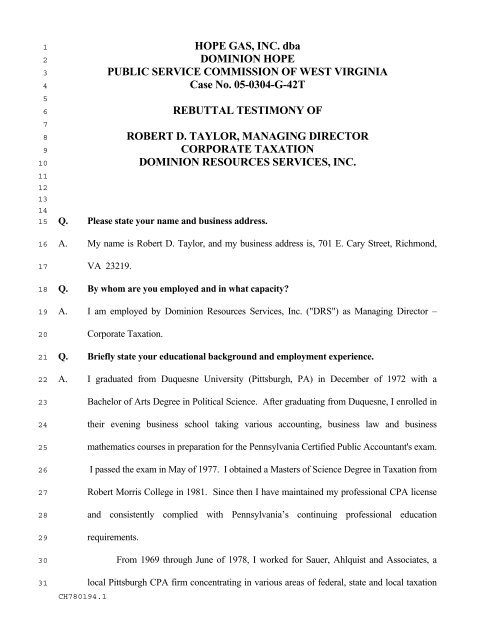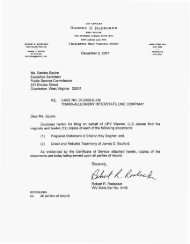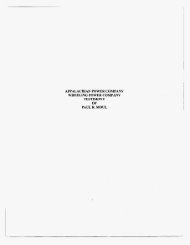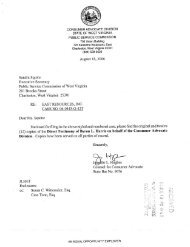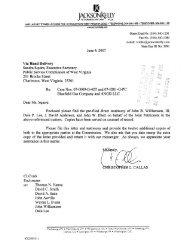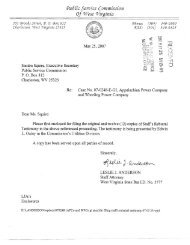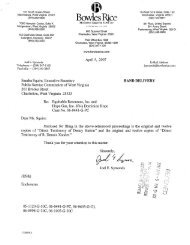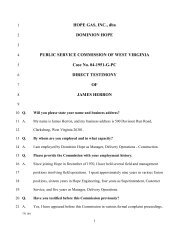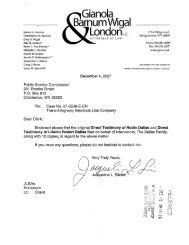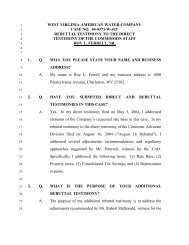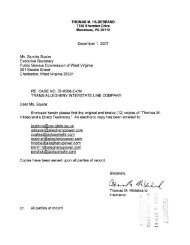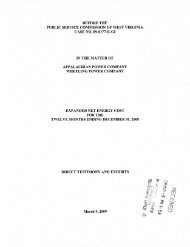Rebuttal Testimony of Robert D. Taylor
Rebuttal Testimony of Robert D. Taylor
Rebuttal Testimony of Robert D. Taylor
You also want an ePaper? Increase the reach of your titles
YUMPU automatically turns print PDFs into web optimized ePapers that Google loves.
12345678910111213141516171819202122232425262728293031CH780194.1HOPE GAS, INC. dbaDOMINION HOPEPUBLIC SERVICE COMMISSION OF WEST VIRGINIACase No. 05-0304-G-42TREBUTTAL TESTIMONY OFROBERT D. TAYLOR, MANAGING DIRECTORCORPORATE TAXATIONDOMINION RESOURCES SERVICES, INC.Q. Please state your name and business address.A. My name is <strong>Robert</strong> D. <strong>Taylor</strong>, and my business address is, 701 E. Cary Street, Richmond,VA 23219.Q. By whom are you employed and in what capacity?A. I am employed by Dominion Resources Services, Inc. ("DRS") as Managing Director –Corporate Taxation.Q. Briefly state your educational background and employment experience.A. I graduated from Duquesne University (Pittsburgh, PA) in December <strong>of</strong> 1972 with aBachelor <strong>of</strong> Arts Degree in Political Science. After graduating from Duquesne, I enrolled intheir evening business school taking various accounting, business law and businessmathematics courses in preparation for the Pennsylvania Certified Public Accountant's exam.I passed the exam in May <strong>of</strong> 1977. I obtained a Masters <strong>of</strong> Science Degree in Taxation from<strong>Robert</strong> Morris College in 1981. Since then I have maintained my pr<strong>of</strong>essional CPA licenseand consistently complied with Pennsylvania’s continuing pr<strong>of</strong>essional educationrequirements.From 1969 through June <strong>of</strong> 1978, I worked for Sauer, Ahlquist and Associates, alocal Pittsburgh CPA firm concentrating in various areas <strong>of</strong> federal, state and local taxation
123456789101112131415161718192021222324<strong>of</strong> individuals, corporations, estates and trusts as well as audits and financial statementcompilations. From July 1978 to February 1980 I worked for another local Pittsburgh CPAfirm by the name <strong>of</strong> Crawford, Ellenbogen and Company in the same capacity.In February <strong>of</strong> 1980, I accepted a position as Senior Auditor at Consolidated NaturalGas Service Company, Inc. In September <strong>of</strong> 1980 I accepted a position in a new department,the Strategic Financial Planning Department as a senior analyst. In September <strong>of</strong> 1984 I wasappointed Assistant Treasurer, Finance in CNG Corporate Treasury Department and inJanuary 1986 transferred to the Tax Department as Assistant Director, Taxes. Since then Ihave progressed to the Director's position and to the Assistant Vice President, Taxesposition. After the merger <strong>of</strong> Consolidated Natural Gas with Dominion Resources, Inc.,(DRI) I accepted the position <strong>of</strong> Director - Corporate Taxation and was subsequentlypromoted to Managing Director – Corporation Taxation.Q. Are you a member <strong>of</strong> any pr<strong>of</strong>essional organizations that address tax issues?A. Yes. I am a member <strong>of</strong> the American and Pennsylvania Institutes <strong>of</strong> Certified PublicAccountants as well as the Tax Executives Institute. In addition, I am a member <strong>of</strong> the TaxCommittees <strong>of</strong> the Interstate Natural Gas Association <strong>of</strong> America (INGAA) and theAmerican Gas Association (AGA).Q. What are your responsibilities as DRS’s Managing Director - Corporate Taxation?A. As Managing Director - Corporate Taxation, I assist in the management and coordination <strong>of</strong>the DRI corporate tax function to ensure compliance with all tax laws in accordance with thehighest standards <strong>of</strong> pr<strong>of</strong>essional competence and integrity. That responsibility entails:establishing system-wide policies for tax matters; furnishing tax advice and guidance tosystem companies; preparing and filing the federal consolidated income tax return includingcoordination and review <strong>of</strong> the preparation <strong>of</strong> subsidiary preliminary tax papers; oversight <strong>of</strong>2
123456789101112the federal, state and local audits; engaging in tax research and planning and consulting withoutside tax counsel; and engaging in special projects and studies concerning majoracquisitions, reorganizations, etc. As part <strong>of</strong> those responsibilities, I am responsible for theoversight <strong>of</strong> Hope's tax functions. That responsibility includes Hopes participation in theconsolidated income tax return filed by the parent, Dominion Resources Inc. (DRI).Q. What is the purpose <strong>of</strong> your testimony in this proceeding?A. I will address the following issues:• Consolidated Tax Adjustment (CTA) proposed by staff and the CAD,• FICA Taxes Error proposed by staff and the CAD,• Rate Base - Accumulated Deferred Taxes - Normalization proposed by staff,• Rate Base - Accumulated Deferred Taxes - FAS 109 proposed by staff and• Other Expense and Rate Base Adjustments.131415161718192021222324Consolidated Tax Adjustment (CTA)This issue is <strong>of</strong> vital importance to the Dominion companies. In the March, 1994 Order onReconsideration in Dominion Hope’s last litigated rate case, Case No. 93-0004-G-42T, theCommission stated “Hope and the other parties will have the opportunity to address thisissue in Hope’s next rate proceeding.” Since then, Dominion Hope has settled (stipulated)cases but has not had a ruling on this issue from the Commission. I realize that thisCommission has a history <strong>of</strong> approving a CTA for companies that are part <strong>of</strong> a consolidatedentity (and in the 1993 case stated its intention to make the adjustment even moredisadvantageous to utilities), but I believe the Commission should revisit this issue because<strong>of</strong> its significance.Q. Please explain the issue <strong>of</strong> a consolidated tax adjustment.3
123456789101112131415161718192021including any related tax benefits should not affect the determination <strong>of</strong> the utility’s ratescharged to its ratepayers.Q. Please explain how the CTA is inconsistent with current FERC policies.A. The Federal Energy Regulatory Commission (FERC) and its predecessor, the Federal PowerCommission, have for years consistently rejected any cost <strong>of</strong> service adjustment for federalincome taxes related to a consolidated tax savings.1 In FERC’s Opinion No. 173, dated June22, 1983 (Columbia Gas Transmission Corporation, Docket No. RP75-106-006) it stated thatthe “the tax allowance should be equal to the tax on the pr<strong>of</strong>it the ratepayer will contribute tothe company. In short, the tax allowance should be equal to the tax on the company’sallowed rate <strong>of</strong> return.” (Emphasis added) The FERC also went on to state that as a result <strong>of</strong>the differences in calculating the earnings due the company and the determination <strong>of</strong> taxableincome “the Commission has found that the taxes the company pays to the Internal RevenueService is not a reliable guide, even as a starting point, for determining a company’s taxallowance.” (Emphasis added) In reiterating the use <strong>of</strong> the “stand-alone income tax method”the FERC stated, “when an expense is not included in the cost <strong>of</strong> service (because thecompany did not incur that expense in providing service), the deduction created by thatexpense is not allocated to the ratepayers.” (Emphasis added)One <strong>of</strong> the arguments made by the City <strong>of</strong> Charlottesville in the Columbia Gasproceeding was that the stand-alone policy violates the statutory mandate that requires thatratepayers reimburse a regulated pipeline only for the “actual cost” including federal incometaxes and is therefore “unlawful”. In response the FERC stated, “We disagree. We do so not1 Florida Gas Transmission Company, 47 FPC 341,362 (1972). Furthermore, thecommission said, “[a]s the pipeline business develops with numeroussubsidiaries we should avoid regulating one company on the basis <strong>of</strong> theactivities <strong>of</strong> others in the affiliated group. …A utility should be regulatedon the basis <strong>of</strong> its being an independent entity; that is a utility should beconsidered as nearly as possible on its own merits and not on those <strong>of</strong> its5
1234567891011121314151617181920212223because we disagree with the principle that only actual costs should be included in the cost<strong>of</strong> service. Everything we have heret<strong>of</strong>ore said in this opinion shows that we are in completeagreement with that principle. Rather, we do so because we cannot agree that the amountsreported to the Internal Revenue Service represents the actual tax cost the pipelines incur inproviding service”. (Emphasis added)There is another aspect related to the Parent Company losses that should bedistinguished from the benefits associated with the accelerated deductions provided underthe Internal Revenue Code and the Treasury Regulations. CNG (Dominion Hope’s Parent)as a holding company conducts no other business activity other than the investment in itssubsidiaries, a substantial portion <strong>of</strong> which includes the financing needs <strong>of</strong> the subsidiaries.As part <strong>of</strong> that process, CNG has typically procured the collective financing for the entireaffiliated group, which has resulted in overall lower financing costs. The interest costcharged to any subsidiary has been at the same rate incurred by the Parent company, whichis required under current SEC regulations. However, in many cases the funds borrowed bythe Parent Company are combined with other cash flow and collectively distributed to theaffiliates as a combination <strong>of</strong> both debt and equity. This is done to maintain an appropriatedebt/equity relationship at the regulated subsidiary, which directly benefits the ratepayers.As a result, the level <strong>of</strong> debt at the subsidiaries does not coincide with the levels <strong>of</strong> debt atthe parent. As a result the total interest expense incurred by the Parent Company is,typically, not <strong>of</strong>fset by the interest payments received from the affiliates. This mismatch isthe prime reason for tax losses incurred at the Parent Company. However, to then allocate aportion <strong>of</strong> the tax benefits associated with the Parent Company losses to the benefit <strong>of</strong> theratepayers without an equal allocation <strong>of</strong> the associated financing cost is financially illogicalaffiliates.” Id at 363.6
123456789101112131415161718192021222324and unfair.Q. Is the CTA consistently applied by all state commissions?A. The CTA is not consistently applied by all state commissions. Dominion’s largest utility isin Virginia. However, the Virginia State Corporation Commission has a long-standingpolicy that the parent company and its subsidiaries should have its tax expense calculated ona stand-alone basis. In Case 19052 (Application <strong>of</strong> General Telephone Company <strong>of</strong> theSoutheast, 1972 SCC Ann. Rep.107 (March 14, 1972)) the State Corporation Commissionheld that the Staff’s adjustment to impute to the utility savings resulting from the use <strong>of</strong> aconsolidated return by its parent was inappropriate. The Commission stated “We are fixingrates for the future, and it is certain that a parent company with many subsidiaries that fileconsolidated returns will have ups and downs every year. There can be no assurance thatlast year’s downs will not be matched by next years ups. The only way to treat a utility’sbusiness as an island by itself is to insulate it from outside nonjurisdictional property,expenses and income.” (Emphasis added)Q. Is the CTA an equitable application <strong>of</strong> ratemaking policy?A. No. Dominion Hope believes that the CTA is an inequitable application for rate-makingpurposes and that it is inappropriate to subsidize regulated companies by the losses incurredby affiliated non-regulated companies when the expenditures that produces the tax deductionare not included in utility rates. Ratepayers should not be entitled to the tax benefits <strong>of</strong>unregulated activities because they did not fund the unregulated activities nor do they bearany <strong>of</strong> the risk.Ratepayers should be charged only the income tax costs and benefits based uponthe revenues and expenses <strong>of</strong> the utility operations. Rates charged for regulated utilityservice should reflect only the cost associated with providing utility service; they should not7
123456789101112131415161718192021222324reflect costs associated with other businesses included in the consolidated tax group. Onlythose costs that are incurred to operate the utility should be allowed in determining cost <strong>of</strong>service. Therefore, in determining the appropriate federal income tax expense, the regulatormust consider only the results <strong>of</strong> the utility’s operations.The CTA also creates an economic inconsistency with respect to the certaindeductions that can result in tax losses. One <strong>of</strong> the reasons Congress provides acceleratedtax deductions is to encourage the investment in new plant and equipment by enhancing therates <strong>of</strong> return on business through rapid depreciation deductions and certain expensing andtax credit provisions. Reducing the revenue <strong>of</strong> regulated affiliates by a portion <strong>of</strong> the taxsavings associated with non-regulated tax benefits reduces the economic benefits and defeatsthe original purpose <strong>of</strong> the tax incentives for the consolidated group as a whole. In additionto reducing or eliminating the tax incentives intended, the CTA does so withoutcompensating the non-regulated affiliate for the business and financial risk that it hasassumed and which is associated with the investment.The mere fact that the payment to the Internal Revenue Service is less than the sum<strong>of</strong> the payments which would have been made if all affiliates filed on a separate basis shouldnot be dispositive as to the definition <strong>of</strong> the “actual tax” for any particular affiliate. To do soconfuses the calculation <strong>of</strong> the tax expense with the actual taxes paid. Instead, theconsolidated tax payment should be viewed as a payment to the Internal Revenue Service bythose affiliates owing tax and a refund to those companies incurring a loss. The fact thatsome affiliates would not be entitled to a “refund” in the current year if they filed on aseparate basis reflects Congress’ intent (within the consolidated tax return provisionscontained in the Internal Revenue Code and the Treasury Regulations) to provide losscompanies the benefits <strong>of</strong> their losses quicker than would otherwise be allowed.8
123456789101112131415161718192021222324In addition, focusing on the net payment emphasizes the “one way street” nature <strong>of</strong>the CTA. For example, many tax losses are caused by accelerated deduction provisionswithin the Internal Revenue Code, the benefits <strong>of</strong> which “reverse” in the future. As such,while an unregulated affiliate may receive tax benefits in an earlier year, the reversal <strong>of</strong> thosebenefits causes an increase in tax in future years. However, under current rate makingpolicies, when those tax benefits reverse at the unregulated subsidiary, the resulting futuretax increases, would never be allocated to a regulated affiliate.Q. Please comment on Staff witness Pauley’s consolidated tax savings testimony andStatement G Adjustment 30.A. Staff witness Pauley’s calculation <strong>of</strong> a CTA can be summarized as an “Average CTAEffective Tax Rate” method. The tax losses <strong>of</strong> the parent holding company (DRI Parent)and the service company (DRS) are incorporated into a prospective tax rate that is applied t<strong>of</strong>uture taxable income.Q. Assuming that the company agreed to a CTA, is the calculation performed by Staffwitness Pauley calculated correctly?A. No. Attached is Exhibit RDT-4, which includes a calculation <strong>of</strong> a “going-level” weightedaverage rate for Hope’s parent company only. The method used by witness Pauley simplyaverages the annual consolidated tax rates for the years 2000 through 2004. Theconsolidated tax rate has been reduced by a “savings rate” which is based on the ratio <strong>of</strong> thetax savings on DRI Parent’s and DRS’s tax losses to the tax on the positive taxable incomecompanies. However, there is distortion created with the calculations for numerous reasons.First <strong>of</strong> all, due to the unusual size <strong>of</strong> DRI Parent’s loss in 2003, the combined losses <strong>of</strong> DRIParent and DRS exceed the total income <strong>of</strong> the income companies. As a result, witnessPauley’s calculation results in a negative adjusted tax rate for 2003; which he recognizes as9
123456789101112131415161718192021222324creating a distortion in the calculation by substituting zero for the negative adjusted tax rate.However, the total distortion has not been eliminated. Although he has eliminated thenegative adjusted tax rate, he has included 2003 in his averaging calculation effectivelyaveraging four years <strong>of</strong> data over a five-year period resulting in a lower average tax rate. Inorder to eliminate all distortions related to 2003, only years 2000, 2001, 2002 and 2004should be included in the calculation and the average based on four years instead <strong>of</strong> fiveyears. Had 2003 been excluded completely, the “consolidated federal tax rate” would havebeen 24.32% compared to 19.30%. See Exhibit RDT-1.Second, Witness Pauley’s calculation includes 12 months <strong>of</strong> DRI Parent and DRSlosses but only 11 months for the income companies. There were actually two returns filedin 2000. A one-month return was filed by the CNG group and included one month’sactivities for the income companies. These changes result in an adjusted consolidated taxrate <strong>of</strong> 24.38%. See Exhibit RDT-2.Third, we believe that the calculation <strong>of</strong> taxable income for both the incomecompanies and the loss companies should reflect “going-level” adjustments by removingnonrecurring items such as the difference between bonus depreciation and regulardepreciation, non-utility generator contract termination costs, losses incurred from thedivestiture <strong>of</strong> Dominion Telecom, the replacement <strong>of</strong> nuclear reactor heads, and theincome and loss <strong>of</strong> companies no longer included in the consolidated federal return. Theinclusion <strong>of</strong> the “going level” adjustments eliminates the distortion related to 2003 andtherefore we have included 2003 in the calculation and used 5 years in the averagingcalculation. The impact <strong>of</strong> these adjustments results in an adjusted consolidated tax rate <strong>of</strong>25.80%. See Exhibit RDT-3.Finally, we believe that including only the tax losses <strong>of</strong> Dominion Hope’s parent10
123456789101112131415161718192021222324company (CNG) is consistent with the calculation staff has proposed in the past. Any costsassociated with the investment in Dominion Hope including financing would be reflected inCNG’s tax losses. The impact <strong>of</strong> this adjustment results in an adjusted consolidated tax rate<strong>of</strong> 34.32%. See Exhibit RDT-4.If the commission should adopt an “Effective Tax Rate” method <strong>of</strong> calculating aCTA, then the weighted average tax rate should be based on a “going-level” calculation thatincludes only the losses <strong>of</strong> Hope’s parent company, CNG. See Exhibit RDT-4.Q. Witness Larkin <strong>of</strong> the CAD states on page 45 <strong>of</strong> his testimony that “If Hope’s proposedrevenue requirement is based on a stand-alone basis versus a consolidatedmethodology, the result will be that the Company’s income tax expense will beoverstated and rates will be higher than they otherwise would be. It would also resultin a larger amount being collected than what will ultimately be paid to the InternalRevenue Service.” Please comment.A. We would not agree and once again reiterate the FERC’s position “that the taxes that acompany pays to the IRS is not a reliable guide, even as a starting point, for determining acompany’s tax allowance.” Taxes are no different than other expenses included in the cost<strong>of</strong> service and should be based on the company’s allowed rate <strong>of</strong> return at the applicablestatutory tax rate. The allocation <strong>of</strong> tax benefits to the ratepayers <strong>of</strong> a regulated affiliate,which are associated with expenditures <strong>of</strong> non-regulated affiliates results in a windfall for theratepayers at the expense <strong>of</strong> the shareholders. In those cases the ratepayers have received thetax savings without the financial risk and burdens <strong>of</strong> the expenses that gave rise to the excessdeductions.Q. Assuming that the company agreed to a CTA, is the calculation performed by CADwitness Larkin in Exhibit LA-1 Schedule C-12 calculated correctly?11
123456789101112131415161718192021222324A. No. Witness Larkin’s method allocates a portion <strong>of</strong> the average tax losses <strong>of</strong> all losscompanies to Dominion Hope based on Dominion Hope’s ratio <strong>of</strong> its positive taxableincome to the sum <strong>of</strong> the positive taxable income companies. Since 2001, 2003 and 2004are loss years for Dominion Hope, witness Larkin does not calculate or include a percentagefor years 2001, 2003 and 2004. These years should be included to provide a true reflection<strong>of</strong> the five years <strong>of</strong> income for Dominion Hope. In addition, the five-year average <strong>of</strong> lossesthat witness Larkin starts with in Exhibit LA-1 Schedule C-12 includes the loss incurred byDominion Hope for the years 2001, 2003 and 2004. Dominion Hope’s losses should beeliminated from the average losses so that it is not utilized twice, once in Dominion Hope’scalculation <strong>of</strong> tax and then again in the proposed CTA. In addition, a “going-level” CTAwould remove nonrecurring items such as the difference between bonus depreciation andregular depreciation, non-utility generator contract termination costs, losses incurredfrom the divestiture <strong>of</strong> Dominion Telecom, the replacement <strong>of</strong> nuclear reactor heads, andthe income and loss <strong>of</strong> companies no longer included in the consolidated federal returnfrom the five-year weighted average. Exhibit RDT-5 makes these corrections and producesa negative weighted average rate and therefore no historical consolidated tax savings that canbe allocated to Dominion Hope under witness Larkin’s method.Q. Does Dominion Hope believe that a consolidated tax savings adjustment isappropriate?A. Absolutely not. Please remember that despite the filing <strong>of</strong> a consolidated tax return, thecompanies are separate and distinct entities. Even though the utility’s income may look likeit allows the current use <strong>of</strong> the unregulated member’s loss, the benefits <strong>of</strong> any tax loss <strong>of</strong> anunregulated affiliate belong to the shareholders <strong>of</strong> that company, not to utility ratepayers.Q. What is the appropriate federal income tax rate, which should be used to calculate12
123federal income taxes in this case?A. The Company’s federal income taxes should be computed using the statutory income tax rate<strong>of</strong> 35%.456789101112131415161718192021222324FICA Taxes ErrorQ. Please comment on Staff witness Sprinkle’s payroll related testimony (beginning onpage 12) regarding the calculation <strong>of</strong> FICA Taxes.A. I agree that Hope incorrectly calculated the going-level FICA Taxes adjustment (StatementG Adjustment 24) by apportioning the operation and maintenance percentage twice. Staffwitness Sprinkle did not include the going-level adjustment for the 2005 FICA base increasein his calculation. The correct going level FICA Taxes adjustment (including the 2005 FICAbase increase) should be $85,605 ($84,563 staff calculation + $1,042 FICA base increase)and not $216,171. This adjustment reduces the FICA Taxes claim by $130,566. See ExhibitRDT-6 for these calculations.Q. Please comment on Staff witness Sprinkle’s payroll related testimony (beginning onpage 14) regarding the calculation <strong>of</strong> FICA Taxes as a result <strong>of</strong> staff’s adjustment tothe going-level payroll expense.A. I agree that a corresponding recalculation <strong>of</strong> FICA Taxes should be made to any going-levelpayroll expense adjustment ultimately made by the commission.Q. Please comment on CAD witness Larkin’s payroll tax expense testimony (beginning onpage 34) regarding the calculation <strong>of</strong> FICA Taxes.A. I agree that Hope incorrectly calculated the going-level FICA Taxes adjustment (StatementG Adjustment 24) by apportioning the operation and maintenance percentage twice. Thecorrect going level FICA Taxes adjustment (including the 2005 FICA base increase) should13
12be $85,605 and not $216,171. This adjustment reduces the FICA Taxes claim by $130,566.See Exhibit RDT-6 for these calculations.3456789101112131415161718Rate Base - Accumulated Deferred Taxes - NormalizationQ. Please comment on Staff witness Pauley’s rate base related testimony (beginning onpage 7) regarding normalization <strong>of</strong> income tax.A. Hope normalizes on all federal temporary differences and all state temporary differencesexcept for liberalized depreciation, CONAG and gain on parent debt reacquisition. Thishas been the practice for ratemaking purposes for many years. The normalization methodfiled in this case is consistent with the normalization method filed by Dominion Hopeover at least the past twelve years. I believe that this normalization method has actuallybeen in place and approved for much longer than twelve years but our review <strong>of</strong> pastDominion Hope cases was limited to the rate case records for the past four DominionHope cases (1993, 1995, 1998 and 2001). In each <strong>of</strong> these cases, the normalizationmethod used by the Company for the items in question is consistent with the methodutilized in this case. No intervening party in these cases raised any issues or questionedDominion Hope’s normalization treatment. The precedent has clearly been set andshould not now be changed.192021222324Rate Base - Accumulated Deferred Taxes - FAS 109Q. Please comment on Staff witness Pauley’s rate base related testimony (beginning onpage 7) regarding FAS 109 Grossups.A. The Accumulated Deferred Income Taxes - FAS 109 Grossups represent deferred incometaxes on flow through (i.e., non normalized) temporary differences that are required under14
1234FAS 109 to be recorded on the financial statements. The corresponding debit is not reflectedon the income statement but is recorded as a regulatory asset on the balance sheet. As such,these deferred income taxes, which have not been provided by the ratepayers, are notrequired to be reflected as a reduction to rate base.567891011121314Other Expense and Rate Base AdjustmentsQ. Witness Larkin made miscellaneous tax adjustments as a result <strong>of</strong> various otherexpense and rate base adjustments. Do you agree with these?A. I agree that corresponding adjustments to Investment Tax Credits, Property Taxes andIncome Taxes may be appropriate should the Commission adopt changes to the Company’sAddendum Rate Base claim. Also, should the Commission decide to modify the Company’sclaim for labor expenses, any associated adjustment for payroll taxes would be appropriate.Q. Does that conclude your testimony?A. Yes.1515


